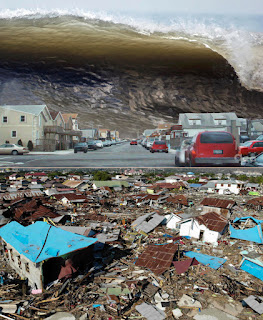4. All of these kinds of destruction had happened before in the land, but never with such terrifying effect.
Once again, sharp lightnings "such as never had been known in all the land" seems like an odd statement to describe something that was common except in its severity. Normally, one would write "more severe than had been seen before" to denote a typical event, not "such as one as never had been known in all the land."
What might have been labeled as lightning by these ancient writers? Flashes in the sky, meteors, hydrogen flares, fireballs? What kind of lightning-like phenomena would be "such as never had been known in all the land?" If it was normal lightning, what caused it to be so different, after all 100 lightning bolts strike the Earth's surface every second, which is about 8 million per day and 3 billion each year.
Usually cloud-to-cloud lightning isn't impressive because it happens
when the sky is uniformly covered in a dense layer of low clouds that don't
have a pronounced shape. However, once in a while the clouds have incredible
form, that provides lightening or flashes views not normally seen in a storm
Thus, for lightening so severe to have never been known in all the land, it was far more than mere lightening. Something about the occurrence had to be considerably different to warrant a comment that it had never been known in all the land.
5. Not surprisingly, the sorts of natural forces unleashed in that fateful three hours are familiar on the Mesoamerican scene.
Generally, earthquakes last less than a minute, two at most. Other meteorological phenomena are usually only a few minutes. Whatever drove the events in the Land of Promise, they were unique and with such unparalleled force and magnitude that they lasted for 3 hours. It is difficult to consider these events and unbelievable devastation as being from natural events typically known to Book of Mormon inhabitants. Or to anyone else, for that matter.
Downtown Los Angeles
skyline—a three minute 8.0 earthquake would destroy the city
6. There were underground claps of thunder which the Nephites could not distinguish from aerial thunderings.
There may well have been underground disruptions sounding like thunder, as well as many other phenomena, and it is also probable the writers could not distinguish the difference. However, this is pure speculation with no supportive scriptural evidence. We only know that the solid mass of the earth was broken up (Helaman 14:21), both above and below the earth (Helaman 14:22). The cracking of solid rock, the forming of seams and cracks, especially if they were extended down through rock mountains, would certainly cause explosion-sounding thunder that would rock the earth as well.
7. Winds blowing south over the Gulf of Mexico "pile up" water against the ("east") coast, inundating areas of low elevation.
Blowing winds that pile water up along the coast can hardly be a major meteorological phenomena causing Book of Mormon recorders to react in such a manner. Even the worst hurricane hitting the coast would not cause the terrifying reactions that such an event as "never before known in all the land."
Top: The world’s worse earthquake-tsunami
destroyed much of a city; Bottom: but did not ”bury” in the ground, since such
water disasters recede as the water goes back into the sea
8. Either this effect of a normal storm or the more profound result from a tropical hurricane sweeping across the Gulf of Campeche could well have caused "that great city Moroni" on that coast to be "sunk in the depths of the sea" (vs 4).
The scriptural record says "the city of Moroni did sink into the depths of the sea" not that the sea was raised up to cover the city like from a flood or tropical hurricane. Many great and notable cities were sunk (3 Nephi 8:14; 9:8), and sunk, after all, means sunk, not covered over. And over these sunken cities, the Lord caused waters "to come up" (3 Nephi 9:7) over them. So deeply were the cities buried in the depths of the water, that "these cities could not be renewed" (4 Nephi 1:9).
9. Burying cities "in the depths of the earth" (3 Nephi 9:6, 8) would have resulted from mud slides, as well as from falling volcanic ash.
The scriptural record says the "earth was carried up upon the city of Moronihah that in the place of the city there became a great mountain" (3 Nephi 8:10). This hardly describes earth falling down upon the city, such as mud slides or volcanic ash. The earth was carried up, not down, to cover the city. Also, Gilgal was sunk and "buried up in the depths of the earth" (3 Nephi 9:6). Being buried in the depths of the earth is hardly being covered over by mud slides or falling ash.
Thus we see that the destruction mentioned in 3 Nephi was far more destructive than merely “the fundamental features of the landscape were not transformed,” but a changing of the entire land, with mountains where none had been, and valleys where once stood mountains. Seashores were changed, canyons formed from the damage beneath the ground, and numerous other changes that were more “than just cosmetic.”







Scientists have discovered lightning as a result of earthquakes. Since this event was enormous it stands to reason the lightning was caused by the quaking and not just the storm clouds or volcanic induced lightning.
ReplyDeleteBadda Bing badda boom! Del nailed it in this one. These were not events like we or anybody else commonly witnesses, or even an intensified version of it.
ReplyDeletePS. Iterry, the lightning is listed as one of the land-changing elements of the tempest. (See 3 Nephi 8:12, 17) That is some serious lightning unlike any we've witnessed.
I agree Todd, this was extremely unusual. Only during the flood would there have been such unusual events.
ReplyDelete